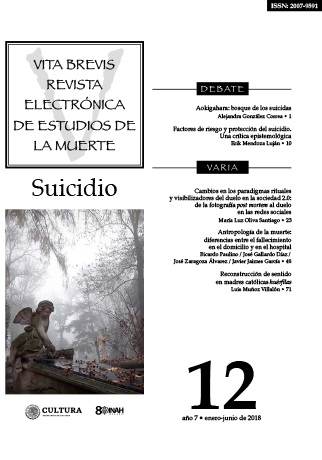Published 2018-06-30
How to Cite
Abstract
Suicide is a phenomenon that afflicts the population worldwide, to the extent that each year the number of deaths from this cause increases. This has motivated the who to create various strategies and policies targeting the prevention of this phenomenon. However, their efforts have not been effective, because today a number of countries still have high suicide rates, including Russia, India, Lithuania, and Japan, the latter the most relevant for the present investigation. Economic, emotional, social, and even supernatural factors have been sufficient reason for the Japanese to decide to end their lives. The forest Aokigahara has been one of the favorite settings for the Japanese who decide to die. But why is it so appealing to commit suicide in that place? The purpose of the present article is to analyze in general some of the beliefs surrounding suicide that have arisen in Japan, particularly in connection with this forest.
Downloads
References
- BBC Mundo, “Aokigahara, el bosque del suicidio de Japón que inspiró una película”, 13 de enero de 2016, recuperado de: http://www.bbc.com/mundo/noticias/2016/01/160112_internacional_japon_bosque_suicida_aokigahara_ng, consultada el 13 de febrero de 2018.
- BBC News, Tokio, 3 de julio de 2015, recuperado de: http://www.bbc.com/news/world-33362387, consultada el 2 de febrero de 2017.
- Berrocal Sarnelli, Álvaro, “Los dioses se han vuelto de fuego. La erupción Jogan del Monte Fuji (864 d. C)”, Revista ARYS, Antigüedad: Religiones y Sociedades, núm. 10, 2012.
- “¿Cómo es el ‘bosque de los suicidios’ de Japón?”, La Nación, 3 de enero de 2018, recuperado de: https://www.lanacion.com.ar/2097561-como-es-el-bosque-de-los-suicidios-de-japon, consultada el 25 de febrero de 2018.
- Danzai, Osamu, “Ubasute” (trad. Virginia Meza), Estudios de Asia y África, vol. 14, núm. 4 (42), México, octubre-diciembre de 1979.
- Galindo, Arturo, “El seppuku, la despedida del samurái”, National Geographic, Madrid, marzo de 2017, recuperado de: http://www.nationalgeographic.com.es/historia/grandes-reportajes/seppuku-despedida-suicida-del-samurai_11256, consultada el 22 de febrero de 2018.
- KoKi, Takahashi, “El monte Fuji. La ciencia ilumina la naturaleza”, en Nipponia, revista electrónica, núm. 35, 15 de diciembre de 2005, recuperado de: http://web-japan.org/nipponia/nipponia35/es/feature/feature01.html, consultada el 11 de julio de 2016.
- OMS, “Prevención del suicidio: un imperativo global. Resumen ejecutivo”, OPS/OMS, recuperado de:https://www.who.int/mental_health/suicide-prevention/exe_summary_spanish.pdf ?ua=1
- “Suicidio. Nota descriptiva”, 2018, recuperado de: http://www.who.int/mediacentre/
- factsheets/fs398/es/, consultada el 24 de enero de 2018.
- Pérez, R., y chida C., Yokai, monstruos y fantasmas en Japón, Gijón, Satori, 2014.
- Requena Hidalgo, Cora, “Seres fantásticos japoneses en la literatura y en el cine: Obakemono, yurei, yokai y kaidan”, Belphégor: Littérature Populaire et Culture, vol. 8, núm. 2, septiembre de 2009, Canadá, recuperado de: http://dalspace.library.dal.ca/handle/10222/47775, consultada el 4 de abril de 2018.
- Tetsuo, Yamaori, “La reverencia hacia el monte Fuji”, Niponica. Descubriendo Japón, núm. 13 (reportaje especial: El Monte Fuji, símbolo de Japón), 31 de octubre de 2014, recuperado de:http://web-japan.org/niponica/pdf/niponica13/no13_es.pdf , consultada el 8 de julio de 2016.
- “Un caso impactante. Una muerte que no es de manual”, Clarín, 13 de octubre de 2011, recuperado de: https://www.clarin.com/investigaciones/muerte-manual_0_SJ3NNlh2wXx.html.
- Valdiviezo, Luis, “Japón y el suicidio”, Observatorio Iberoamericano de la Economía y la Sociedad del Japón, vol. 5, núm. 17, mayo de 2013, recuperado de: http://www.eumed.net/rev/japon/, consultada el 27 de marzo de 2018.
- Wingfield-hayes, Rupert, “¿Por qué Japón tiene una tasa de suicidios tan alta?”.

